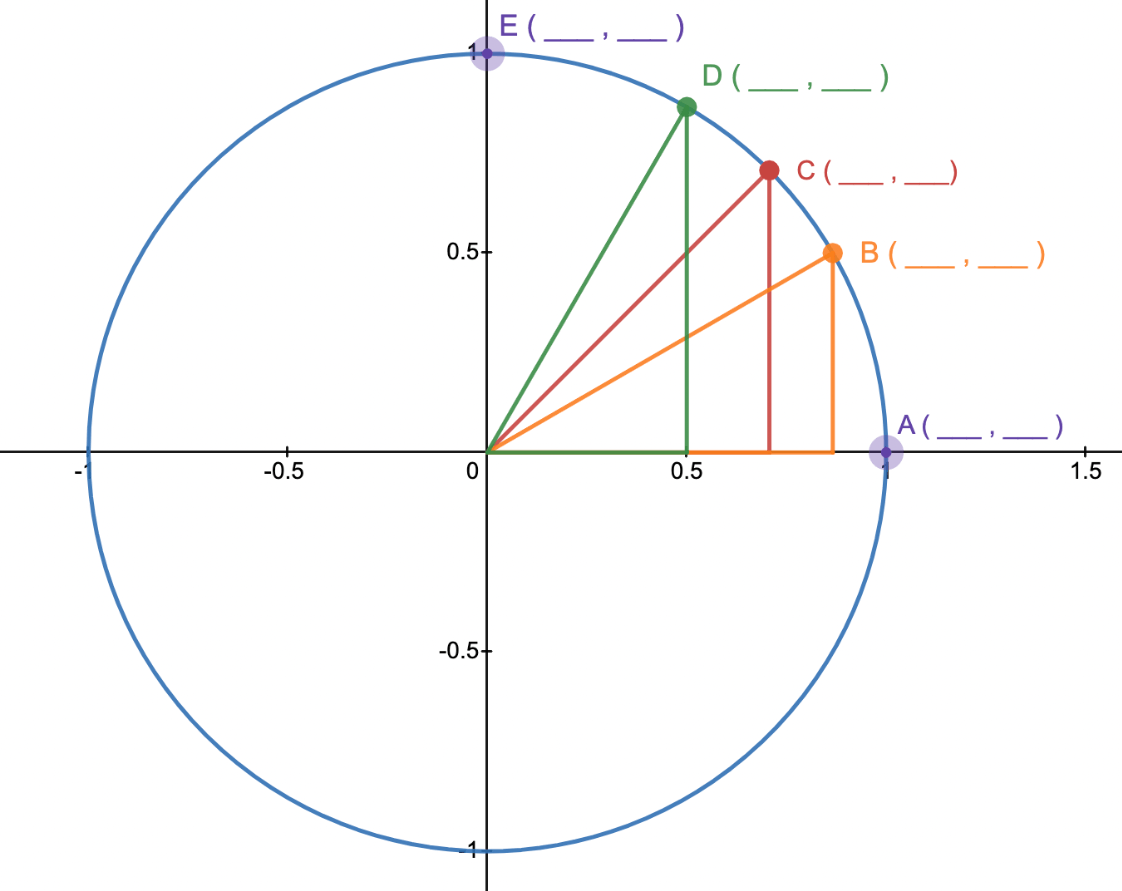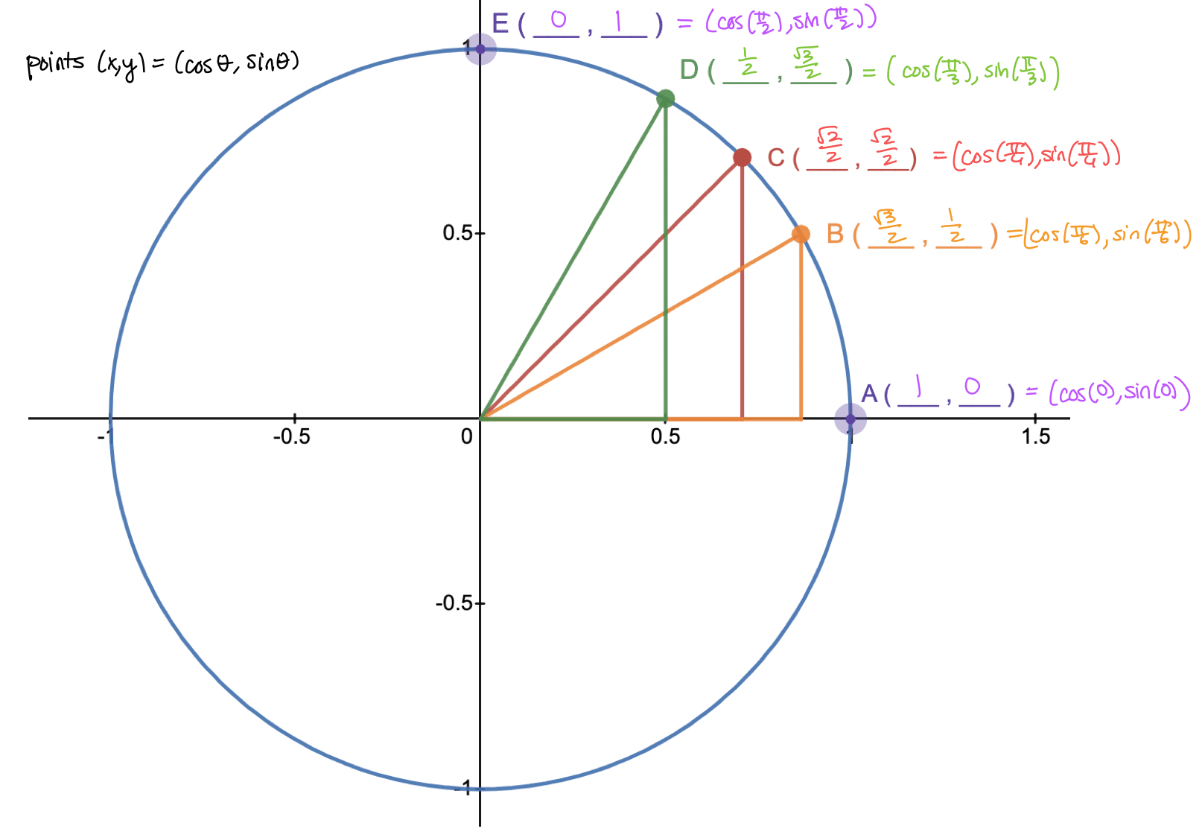Suppose f(x) = x^2. What is the domain of f ? What is the range of f ?
Domain of f: the set of all real numbers \mathbb{R}
Range of f: the set of all non-negative, real numbers {x\in \mathbb{R} | x\geq 0}
What is the slope of the following line? What is its y-intercept?
y = \frac{2}{5}x+3
\text{slope }m = \frac{2}{5}
y\text{-intercept }b = 3
For which pairs of consecutive points int he following figure is the function graphed: increasing & concave up, increasing & concave down, decreasing & concave up, and decreasing & concave down?
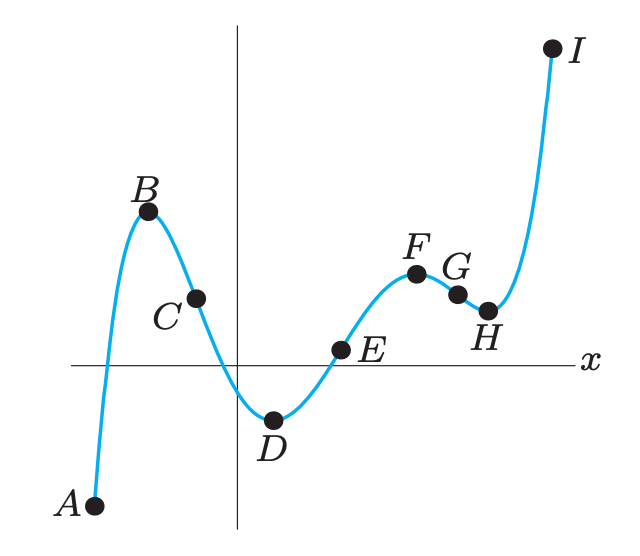
Increasing & CU: (D,E), (H,I)
Increasing & CD: (A,B), (E,F)
Decreasing & CU: (C,D), (G,H)
Decreasing & CD: (B,C), (F,G)
Describe the steps you need to do to compute f(g(1)) for any functions f(x) and g(x).
(1) Compute g(1)
(2) Note that g(1) represents some number. We plug this number into f(x) to get f(g(1))
Completely simplify the expression
5e^{\ln(a^2)}
5a^2
Determine the end behavior of the following function as x approaches positive infinity and as x approaches negative infinity.
f(x) = -10x^5
\text{As }x\rightarrow +\infty, f(x)\rightarrow -\infty
\text{As }x\rightarrow -\infty, f(x)\rightarrow +\infty
\text{Find the exact values of}\cos(0) and \sin(0).
cos(0)=1, sin(0)=0
Give the approximate domain and range of the following function. Assume the entire graph is shown.
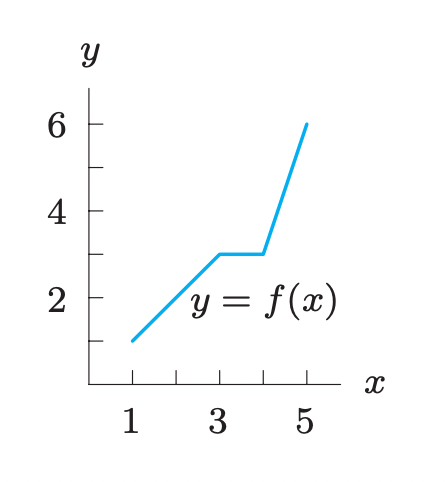
Domain of f is {x\in \mathbb{R} | 1 \leq x \leq 5}
Range of f is {x\in \mathbb{R} | 1 \leq x \leq 6}
Determine the slope and y-intercept of the line whose equation is
7y+12x-2=0
\text{slope }m=-\frac{12}{7}
y\text{-intercept }b= \frac{2}{7}
Consider the following exponential growth function, where P is a population (in thousands) and t is a unit of time. What is the initial population? What is the growth rate?
P=3.2e^{0.03t}
P_0=3.2 \text{ (3200 people) }
a=e^{0.03} \text{ (~3% increase per unit of time)}
Compute f(g(1))\text{ and }g(f(1)) given the following functions
f(x)=sqrt(x+4)\text{ and }g(x)=x^2
f(g(1))=sqrt5
g(f(1))=5
Completely simplify the expression
\ln(1/e) + \ln(ab)
\ln(a)+\ln(b)-1
Determine the end behavior of the following function as x approaches positive infinity and as x approaches negative infinity.
f(x)=e^x
\text{As }x\rightarrow +\infty, f(x)\rightarrow +\infty
\text{As }x\rightarrow -\infty, f(x)\rightarrow 0
Convert the following radians into degrees
\text{(a) } \frac{3\pi}{2}
\text{(b) } \frac{5\pi}{3}
\text{(a) } \frac{3\pi}{2} = 270 \text{ degrees}
\text{(b) } \frac{5\pi}{3} = 300 \text{ degrees}
Find the domain and range of
\frac{1}{x^2+2}
Domain is \mathbb{R}
Range is {y\in \mathbb{R} | 0 < y \leq \frac{1}{2}}
Find the equation for the line that passes through the points (-1,0) and (2,6).
y=2x+2
Consider the following exponential functions. Which represent exponential growth and which represent exponential decay?
\text{(a) }P=15e^{0.25t}
\text{(b) }P=e^{0.2t}
\text{(c) }P=2e^{-0.5t}
\text{(d) }P=7e^{-\pi t}
(a) and (c) are exponential growth functions
(b) and (d) are exponential decay functions
Compute f(g(x)),\text{ }g(f(x)), and f(x)g(x) if f(x)=1/x, g(x)=3x+4
f(g(x)) = 1/(3x+4)
g(f(x)) = 3/x + 4
f(x)g(x) = (3x+4)/x
Solve for x.
2x-1=e^{\ln(x^2)}
x=1
Determine the end behavior of the following function as x approaches positive infinity and x approaches negative infinity.
f(x)=\frac{6+5x-3x^2}{x^2-4}
\text{There is a horizontal asymptote at }y=-3.
Find point P and the indicated angle \theta.
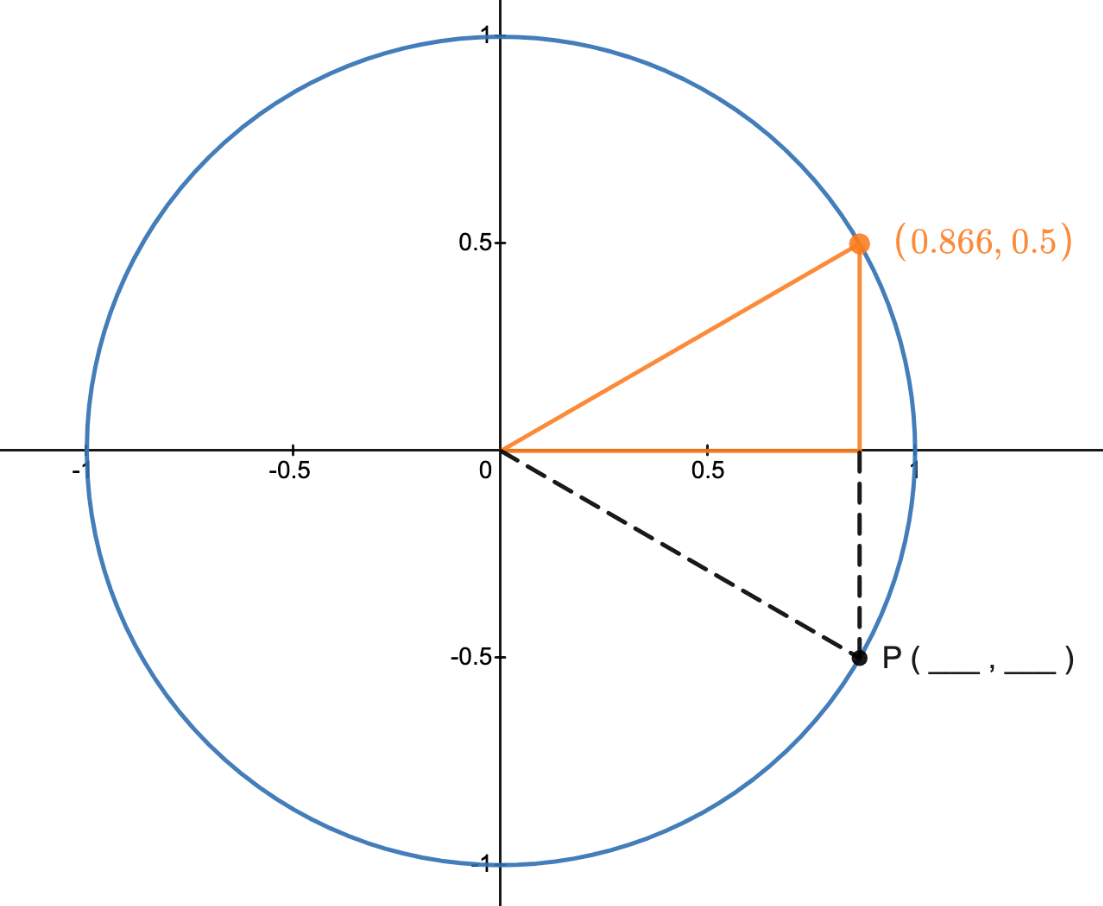
\text{Point }P=(\frac{\sqrt(3)}{2},-\frac{1}{2})
\text{Angle }\theta=\frac{\pi}{6} \text{ or }30\text{ degrees}
Find all values of t for which f(t) is a real number. Then solve for f(t) = 3.
f(t) = sqrt{t^2-16}
f(t)\text{ is real when }t\leq -4\text{ or }t\geq 4
t= pm5
Match the graphs below with the following equations. Note that graphs may not be drawn to scale.
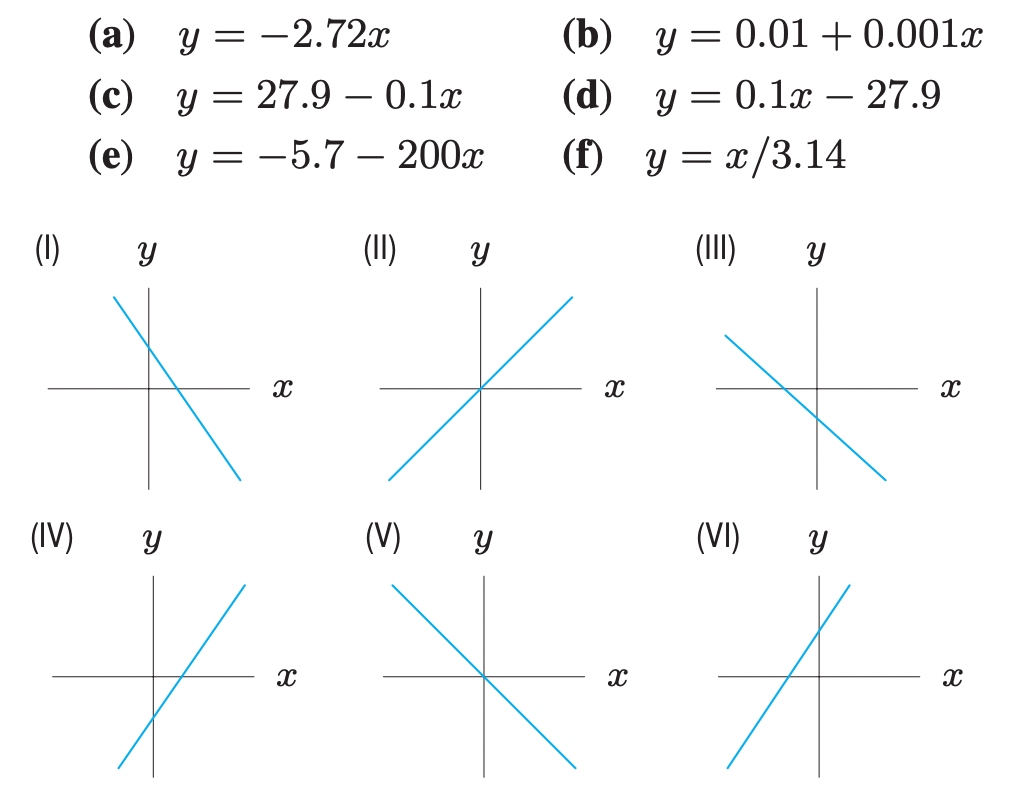
(a) = graph (V)
(b) = graph (VI)
(c) = graph (I)
(d) = graph (IV)
(e) = graph (III)
(f) = graph (II)
A town has a population of 1000 people at time t = 0. Write a formula for the population, P, of the town as a function of year t, if
(1) the population increases by 50 people each year
(2) the population increases by 5% each year.
Explain how they are different.
\text{(1) Formula for increase of 50 each year: }P=1000+5t
\text{(2) Formula for increase of 5% each year: }P=1000(1.05)^t
\text{(1) is linear growth and (2) is exponential growth}
If f(x)=x^2+3 , find and simplify f(t^2+1) and (f(t))^2+1 .
f(t^2+1) = t^4 + 2t^2 + 4
(f(t))^2+1 = t^4 + 6t^2 + 10
Solve for x.
7^{x+2}=e^{17x}
x=\frac{-2\ln(7)}{\ln(7)-17}
Find a cubic polynomial for the following graph.
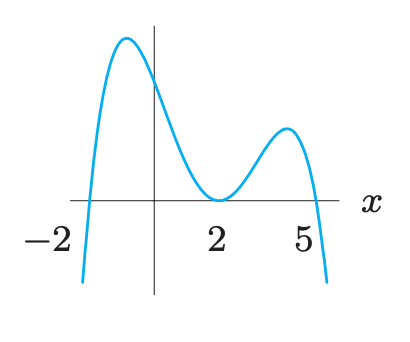
f(x)=(x+2)(x-2)(x-5)
Find the indicated angle using the following image of the unit circle.
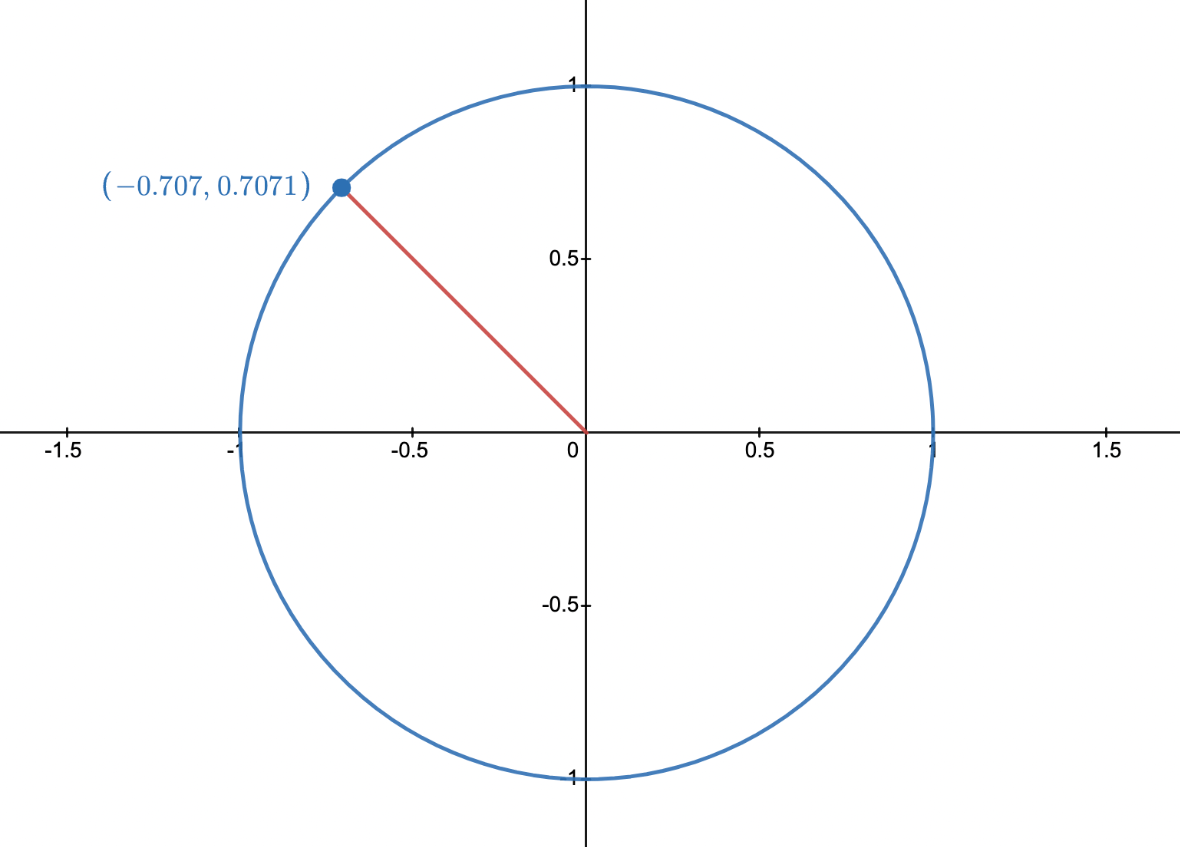
\theta=\frac{3\pi}{4}\text{ or }135 \text{ degrees}
Which of the following functions has its domain identical with its range?
f(x) = x^2,\text{ } g(x) = sqrt(x)
h(x)=x^3,\text{ } i(x) = |x|
\text{Domain and range of }g(x)\text{ is }{x\in \mathbb{R} | x\geq 0}
\text{Domain and range of }h(x)\text{ is }\mathbb{R}
Find equations for the lines through the point (1,5) that are parallel to and perpendicular to the line with equation y+4x=7.
\text{Parallel line: }y=-4x+9
\text{Perpendicular line: }y=\frac{1}{4}x+\frac{19}(4}
In 2010, the world's population reached 6.91 billion and was increasing at a rate of 1.1% per year. Assume that the growth rate remained constant.
\text{(a) Write a formula for the world population (in billions) as}
\text{a function of the number of years since 2010.}
\text{(b) Using the formula from (a), estimate the population of the world in 2020}
\text{(c) The current world population is ~7.87 billion.}
\text{How does this different from the estimate in (b)?}
\text{What does this mean for the growth rate?}
\text{(a) }P=6.91(1.01)^t
\text{(b) }P(11) = 6.91(1.01)^{11} = 7.79 \text{ (7.79 billion people)}
\text{(c) Because the actual population > estimated population, the growth rate must have increased since 2010.}
If g(x)=x^2-2x+1 , compute the following
\frac{g(1+h)-g(1)}{h}
h
Solve for x.
4e^{2x-3}-5=e
x=\frac{\ln(e+5)-\ln(4)+3}{2}
Find all horizontal and vertical asymptotes for the following rational function
f(x)=\frac{x^2+5x+4}{x^2-4}
\text{There are vertical asymptotes at }x=\pm2
\text{There is a horizontal asymptote at }y=1
Fill out the first quadrant of the unit circle.
